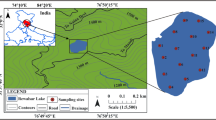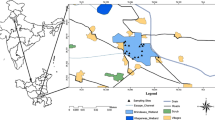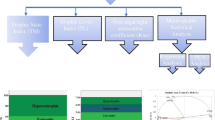Abstract
The present study is to evaluate trophic status and its limiting factors in the Renuka Lake, using surface water samples. The water of the lake is found to be slightly alkaline with pH 8.33–8.70 (avg. 8.61 ± 0.1). The turbidity 4.63–6.62 NTU (avg. 5.48 ± 0.63 NTU) indicated low level of clarity in the lake. The Carlson’s index based on the Secchi disc transparency (SD), chlorophyll-a (Chl-a), and total phosphorus (TP) has indicated that the Renuka Lake is turned hyper-eutrophic in status. The correlation coefficient has indicated that most parameters in the lake are contributed by different sources. Factor-1 marked 26.40% variance, which may be due to higher impact of rock weathering than the anthropogenic activities, whereas 18.56% variance shown by factor-2 may be due to natural and anthropogenic activities. However, factor-3 (14.38% variance) inferred that the higher contribution of Chl-a, pH, TDS, NH4+, NO3−, salinity, and SO42− is due to major impacts of the anthropogenic activities. The inverse distance weighting method has indicated spatial interpolation and area of influence of different parameters in the lake. The “nutrient (TP) limited large sized algae” as well as phosphorus is considered as a major limiting factor for increasing productivity and trophic state index. The present study has inferred that the nutrient enrichment should be controlled to restore the Renuka Lake, owing to its social and ecological significances.



Similar content being viewed by others
References
Alexakis, D., Gotsis, D., & Giakoumakis, S. (2012). Assessment of drainage water quality in pre-and post-irrigation seasons for supplemental irrigation use. Environmental Monitoring and Assessment, 184(8), 5051–5063.
APHA. (2012). Standard method for the examination of water and wastewater (22nd ed.). Washington DC: American Public Health Association ISBN- 9780875530139.
Axler, R. P., & Owen, C. J. (1994). Measuring chlorophyll and phaeophytin: whom should you believe? Lake and Reservoir Management, 8(2), 143–151.
Barki, D. N., & Singa, P. (2014). Assessment of trophic state of lakes in terms of Carlson’s trophic state index. International Journal of Innovative Research In Science, Engineering and Technology, 3(7), 14297–14302.
Boros, E., Jurecska, L., Tatar, E., Voros, L., & Kolpakova, M. (2017). Chemical composition and trophic state of shallow saline steppe lakes in central Asia (North Kazakhstan). Environmental Monitoring and Assessment, 189(11), 546.
Carlson, & Robert, E. (1977). A trophic state index for lakes. Limnology and Oceanography, 22(2), 361–369.
Carlson, & Robert, E. (1991). Expanding the trophic state concept to identify non-nutrient limited lakes and reservoirs. Enhancing the states’s lake management programs. pp. 59–71.
Chakrapani, G. J. (2002). Water and sediment geochemistry of major Kumaun Himalayan lakes, India. Environmental Geology, 43, 99–107.
Das, B. K., & Kaur, P. (2001). Major ion chemistry of Renuka Lake and weathering processes, Sirmaur District, Himachal Pradesh, India. Environmental Geology, 40, 908–917.
Das, B. K., Gaye, B., & Kaur, P. (2008). Geochemistry of Renuka Lake and wetland sediments, lesser Himalaya (India): Implication for source-area weathering, provenance and tectonic setting. Environmental Geology, 54, 147–163.
Dixit, S., & Tiwari, S. (2005). Nutrient overloading of freshwater lake in Bhopal, India, Earth day, 21, ISSN-1076-7975.
Echaniz, S. A., & Vignatti, A. M. (2013). Trophic status of shallow lakes of La Pampa (Argentina) and its relation with the land use in the basin and nutrient internal load. Journal of Environmental Protection, 4(11), 51–60.
Edmondson, W. T. (1980). Secchi disk and chlorophyll. Limnology and Oceanography, 25(2), 378–379.
Elmaci, A., Ozengin, N., Teksoy, A., Topac, F. O., & Baskaya, H. S. (2009). Evaluation of trophic state of lake Uluabat, Turkey. Journal of Environmental Biology, 30(5), 757–760.
Gaury, P. K., Meena, N. K., & Mahajan, A. K. (2018). Hydrochemistry and water quality of Rewalsar Lake of lesser Himalaya, Himachal Pradesh, India. Environmental Monitoring and Assessment, 190(2), 84.
Grzetic, I., & Camprag, N. (2010). The evolution of the trophic state of the Palić Lake (Serbia). Journal of the Serbian Chemical Society, 75(5), 717–732.
Guyuan, L., Faping, B., Xiaoyi, X., Jia, C., & Weiqun, S. (2011). Seasonal variation of dissolved inorganic nutrients transported to the Linjiang bay of the three gorges reservoir China. Environmental Monitoring and Assessment, 73, 55–64.
Havens, & Karl, E. (2000). Using trophic state index (TSI) values to draw inferences regarding phytoplankton limiting factors and seston composition from routine water quality monitoring data. Korean Journal of Limnology, 33, 187–196.
Jafri, S. I. H., Mahar, M. A., Baloch, W. A., & Narejo, N. T. (2006). Trophic State Index, morphoedaphic index and fish yield prediction in a sub-tropical lake, Manchar (Sindh), Pakistan. Bangladesh Journal of Fisheries Research, 10(2), 131–137.
Jekatierynczuk-Rudczyk, E., Zielinski, P., Grabowska, M., Ejsmont-Karabin, J., Karpowicz, M., & Więcko, A. (2014). The trophic status of Suwałki Landscape Park lakes based on selected parameters (NE Poland). Environmental Monitoring and Assessment, 186(8), 5101–5121.
Jindal, R., Thakur, R. K., Singh, U. B., & Ahluwalia, A. S. (2014). Phytoplankton dynamics and species diversity in a shallow eutrophic, natural mid-altitude lake in Himachal Pradesh (India): role of physicochemical factors. Chemistry and Ecology, 30(4), 328–338.
Kehayias, G., & Doulka, E. (2014). Trophic state evaluation of a large Mediterranean lake utilizing abiotic and biotic elements. Journal of Environmental Protection, 5(1), 17.
Kowalczewska-Madura, K., Dondajewksa, R., Goldyn, R., & Podsiadlowski, S. (2017). The influence of restoration measures on phosphorus internal loading from the sediments of a hyper-eutrophic lake. Environmental Science and Pollution Research, 24, 14417–14429.
Lee, Y., Lee, B., Hur, J., Min, J. O., Ha, S. Y., Ra, K., Kim, K. T., & Shin, K. H. (2016). Biodegradability of algal-derived organic matter in a large artificial lake by using stable isotope tracers. Environmental Science and Pollution Research, 23(9), 8358–8366.
Liao, M., Ge, Y., & Ya, G. (2017). Eutrophication in Poyang Lake (eastern China) over the last 300 years in response to changes in climate and lake biomass. PLoS One, 12(1), e0169319.
Lo, C. P., & Yeung, A. K. W. (2002). Concepts and techniques of geographic information systems (p. 350). Upper Saddle River: Prentice-Hall.
Lu, Y., Wang, J., Zhang, X., & Kong, F. (2016). Inhibition of the growth of cyanobacteria during the recruitment stage in Lake Taihu. Environmental Science and Pollution Research, 23(6), 5830–5838.
Ochocka, A., & Pasztaleniec, A. (2016). Sensitivity of plankton indices to lake trophic conditions. Environmental Monitoring and Assessment, 188(11), 622.
OECD. (1982). Eutrophication of waters: monitoring, assessment and control. Paris: Technical Report, Environmental Directorate, OECD, pp 147.
Ogawa, H., Amagai, Y., Koike, I., Kaiser, K., & Benner, R. (2001). Production of refractory dissolved organic matter by bacteria. Science, 292(5518), 917–920.
Pathak, H., & Pathak, D. (2012). Eutrophication: impact of excess nutrient status in lake water ecosystem. Journal of Environmental & Analytical Toxicology, 2(5), 148–156. https://doi.org/10.4172/2161-0525.1000148.
Qi, H., & Lu, J. (2016). Water age prediction and its potential impacts on water quality using a hydrodynamic model for Poyang Lake, China. Environmental Science and Pollution Research, 23(13), 13327–13341.
Qin, L., Zeng, Q., Zhang, W., Li, X., Steinman, A. D., & Du, X. (2016). Estimating internal P loading in a deep water reservoir of northern China using three different methods. Environmental Science and Pollution Research, 23(18), 18512–18523.
Rahmati, R., Pourgholam, R., Najafpour, S. H., & Doustdar, M. (2011). Trophic status of a shallow lake (north of Iran) based on the water quality and the phytoplankton community. World Applied Sciences Journal, 14, 112–120.
Rai, S. P., Kumar, V., Singh, O., Kumar, B., & Jain, A. (2001). Limnological Study of the Mansar lake of District Udhampur, J&K, Final Project Report, NIH WHRC, Jammu cant.
Saluja, R., & Garg, J. K. (2017). Trophic state assessment of Bhindawas Lake, Haryana, India. Environmental Monitoring and Assessment, 189(1), 32.
Sarkar, S., Prakasam, M., Banerji, U. S., Bhushan, R., Gaury, P. K., & Meena, N. K. (2016). Rapid sedimentation history of Rewalsar Lake, Lesser Himalaya, India during the last fifty years - estimated using 137Cs and 210Pb dating techniques: a comparative study with other North-Western Himalayan lakes. Himalayan Geology, 37(1), 1–7.
Schindler, D. W. (2012). The dilemma of controlling cultural eutrophication of lake. Proceedings of the Royal Society B. https://doi.org/10.1097/rspb.1032.
Sharma, M. P., Kumar, A., & Rajvanshi, S. (2010). Assessment of trophic state of lakes: a case of Mansi Ganga Lake in India. Hydro Nepal: Journal of Water, Energy and Environment, 6, 65–72.
Sheela, A. M., Letha, J., & Joseph, S. (2011). Environmental status of a tropical lake system. Environmental Monitoring and Assessment, 180(1–4), 427–449.
Singh, O., Rai, S. P., Kumar, V., Sharma, M. K. & Choubey, V. K. (2008). Water quality and eutrophication status of some lakes of the western Himalayan region (India). Proceeding of Taal- 2007: the 12th world lake conference, pp. 286–291.
Upadhyay, R., Pandey, A. K., Upadhyay, S. K., Bassin, J. K., & Misra, S. M. (2012). Limnochemistry and nutrient dynamics in Upper Lake, Bhopal, India. Environmental Monitoring and Assessment, 184(11), 7065–7077.
Ward, B. B. (2008). Nitrification in marine systems. Nitrogen in the marine environment, 2, pp. 199–261.
Wetzel, R. G. (2001). Limnology: lake and river ecosystems. Gulf professional publishing.
Xu, Y., Cai, Q., Han, X., Shao, M., & Liu, R. (2010). Factors regulating trophic status in a large subtropical reservoir, China. Environmental Monitoring and Assessment, 169(1–4), 237–248.
Ye, L., Han, X. Q., Xu, Y. Y., & Cai, Q. H. (2007). Spatial analysis for spring bloom and nutrient limitation in Xiangxi Bay of Three Gorges Reservoir. Environmental Monitoring and Assessment, 127(1–3), 135–145.
Yu, H., Xi, B., Jiang, J., Heaphy, M. J., Wang, H., & Li, D. (2011). Environmental heterogeneity analysis, assessment of trophic state and source identification in Chaohu Lake, China. Environmental Science and Pollution Research, 18(8), 1333–1342.
Yuzawa, H., Mori, T., Itoh, H., & Yoshida, H. (2012). Reaction mechanism of ammonia decomposition to nitrogen and hydrogen over metal loaded titanium oxide photocatalyst. The Journal of Physical Chemistry C, 116(6), 4126–4136.
Acknowledgements
The authors thank the Hon’ble Vice Chancellor, Central University of Himachal Pradesh (CUHP) for his support and the In-charge, GB Pant National Institute of Himalayan Environment and Sustainable Development, Mohal Kullu, Himachal Pradesh, India, for undertaking the lab analysis. The authors acknowledge the Director, Wadia Institute of Himalayan Geology, Dheradun, India. Dr. Khem Raj Sharma, Assistant Professor, Department of English and European Languages, CUHP, is highly acknowledged for editing the manuscript. The authors are also thankful to the administration of the Renuka Lake for providing boat facility during collection of the water samples.
Author information
Authors and Affiliations
Corresponding author
Additional information
Publisher’s note
Springer Nature remains neutral with regard to jurisdictional claims in published maps and institutional affiliations.
Rights and permissions
About this article
Cite this article
Kumar, P., Mahajan, A.K. & Meena, N.K. Evaluation of trophic status and its limiting factors in the Renuka Lake of Lesser Himalaya, India. Environ Monit Assess 191, 105 (2019). https://doi.org/10.1007/s10661-019-7247-0
Received:
Accepted:
Published:
DOI: https://doi.org/10.1007/s10661-019-7247-0




